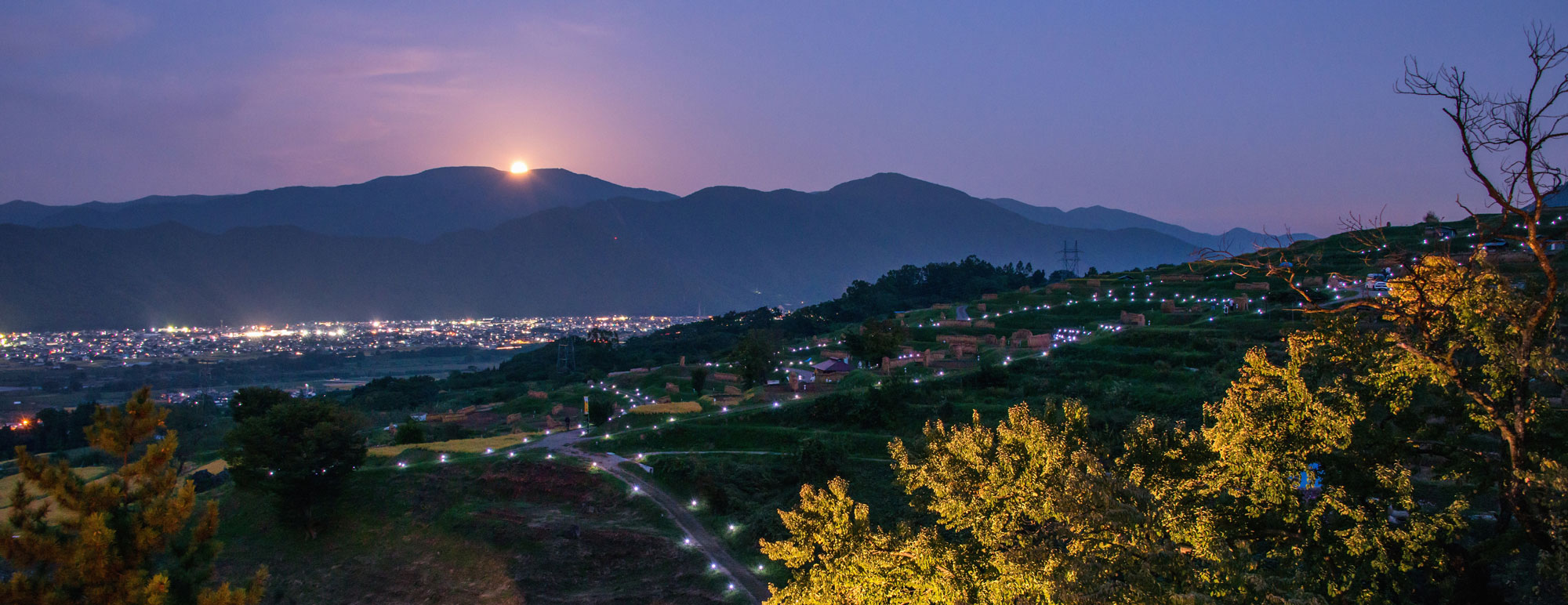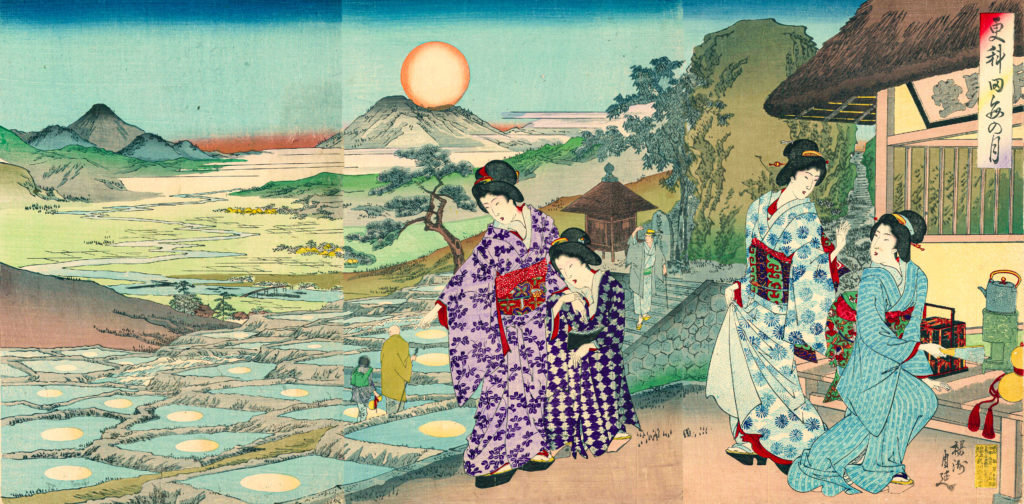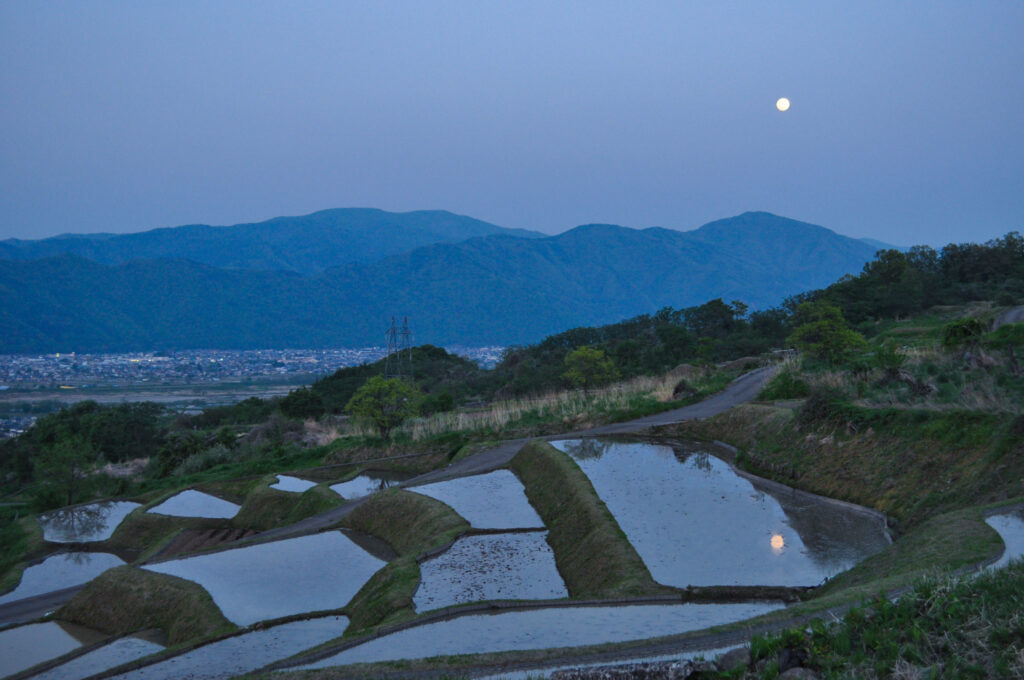Chikuma - the Moon Capital story

Outline of Japan Heritage

Japanese tangible and intangible cultural properties/assets, i.e. regional histories, traditions and customs, are passed down for generations through narratives.
These stories, telling of the legacy of our culture and histories, have been designated as “Japan Heritage” by the Agency of Cultural Affairs.
Chikuma – the Moon Capital
“Moon in Every Paddy Field”, the Mysterious View of Moon Reflected
on the Surface of Obasute’s Terraced Paddy Fields
Chikuma – the Moon Capital
“Moon in Every Paddy Field”,
the Mysterious View of Moon Reflected
on the Surface of Obasute’s Terraced Paddy Fields
The Story(Suggested Title: 3 Views of the Moon from Chikuma
Surrounded by mountains to the east and west, Chikuma City is nestled in a narrow valley along its eponymous river (Chikuma-gawa – the longest river in Japan).
From long ago it has been an important stopover point for travelers.
1252-meter tall Mt. Kamuriki towers over the left bank. Its nickname, “Obasute Mountain”, refers to the ancient legend about abandoning elderly people on the mountaintop.
For as long as anyone can remember, the area around the base of the mountain has been renowned for its stunning views of the moon, especially one phenomenon known as “Tagoto no Tsuki”.
Today, we will look at 3 different perspectives on the Moon’s relationship with the City of Chikuma.
As seen in the diagram, these are:
- The “Poetic Playfulness of People of Old” when viewing the moon
- Ancestors’ “Wisdom of Life” passed down through generations, such as The Obasute Folktale and the area’s terraced rice fields.
- “The Land of Moon Viewing”: a proud and long-running tradition that continues today.
1. The Poetic Playfulness of Old
Choraku-Ji Temple contains, within its grounds, Stone Monuments inscribed with poetry.
Additionally, mysterious and enchanting “ukiyo-e” and “nishiki-e” woodblock prints describe the “moon reflecting in each paddy field”.
2. The Wisdom of Life
Passed down by ancestors. Examples include the Obasute Folktale, the process for cultivating rice fields and local religious practices.
3. The Land of Moon Viewing
Moon viewing in historical tradition, in the recent past, and today.
Let us now look at each of these perspectives in greater detail.
1. The Poetic Playfulness of Old
As referenced in classical poetry, Chikuma is an enchanting spot for viewing the moon.
“Gazing at the moon/shining on Sarashina/on Obasute/ Hill of the abandoned aunt/ I searched in vain for heart’s ease.”
Mt. Obasute, mentioned here in the “Kokin Wakashu”, an anthology of poetry from the Heian Period, is known today as Mt Kamuriki.
Back then, a side road of the “Tosando” highway, which ran from Shinano Province to Kyoto passed through this area.
The “Sarashina Gun-ei” (ancient administrative center) was located at the foot of the mountain.
As such, Mt. Obasute was a landmark for people passing through.
The “waka”-style poem describes how looking up at the moon evoked a sense of loneliness, since most travelers who passed through here would be far from their homes.
The people in Kyoto, which was Japan’s capital city at the time, who learned about Mt. Obasute from the “waka” poem must have felt loneliness and melancholy too, as they longed to see the moon shine on the mysterious Mt. Obasute.
“With a promise to keep in the distant moonlight capital I gaze at the moon over Sarashina on this long autumn night”.
In this extract from a poem by Fujiwara No Teika, a prominent Kamakura Period Poet who is known for compiling the “Shin Kokin Waka Shu”, praises the Chikuma area as the “Moonlight Capital”.
The Moon Rising Over Mt. Kyodai, the “Mirror-Stand Mountain”
“I see a vision / an old woman crying alone / with the moon as her friend.”
During the Edo Period, Matsuo Basho came to view the Moon over Mt. Obasute and wrote this poem, based on the mountain’s folktale. It was later included in the travelogue: “Sarashina Kiko.”
It is believed Basho wrote the poem as he watched the moon rise over Mt. Kyodai (Mirror Stand Mountain).
Mt. Kyodai was given this moniker because some say it looks like a stand on which the moon rests, like a mirror.
Ever since Basho visited Choraku-ji Temple in Obasute, many other writers and artists have followed his footsteps there, in pursuit of similar inspiration.
In the temple compound there is a stone monument called “Basho Omokagezuka”.
The above poem by Basho is engraved there and it contains an artifact of the poet.
Many other stones are also engraved with haiku and Waka poems.
Through reading these, you can feel that same deep appreciation for the beauty of the moon, and understand why Obasute came to be known as the “Moonlight Capital”.
The mysterious “Tagoto no Tsuki” (Moon reflecting in each paddy field)
Each year, in late May, around the time that rice crops are seeded, it is said the moon can be seen reflected on the surface water multiple terraced paddy fields around Obasute.
This is known as the “Moon reflecting in each paddy field” This style of Moon viewing is unique to the area.
Utagawa Hiroshige, an “ukiyoe” artist of the Edo period, recreated this image on one of his woodblock prints.
It was through this “ukiyoe” that the image of the “Moon reflecting in each paddy field ” first gained wider prominence.
In actuality, it is not possible to see the Moon reflected in all the terraced paddy fields at the same time.
However you can see the Moon’s reflection in one paddy field after another as you walk along the footpaths that run between them.
The first written reference to the “Moon reflecting in each paddy field” can be found in a prayer written by Uesugi Kenshin. Uesugi Kenshin was the feudal lord of Echigo Province (modern day Niigata Prefecture).
The prayer was originally composed to pray for victory in the Battle of Kawanakajima, during the period of warring states.
The prayer describes the vista of the Moon shining over Mt. Obasute beyond the terraced paddy fields as seen from the Hachiman Shrine (Takemizuwake Jinja) as the “view of the full moon in every paddy field”.
It is also likened to a vision of Amida Buddha (a common deity in Japanese Buddhist Sects, characterized by a moon like halo behind him) appearing from behind the mountain.
The “Moon in every paddy field” also appears as a famous Shinano Province sight, in the script of the comical Noh play “Tokusa” from the same period.

painted by Yoshu Chikanobu

actually looks

painted by Utagawa Hiroshige
2. Ancestors’ Wisdom of Life
The “Obasute Folktale”
Mt. Obasute is mentioned in “Yamato Monogatari” (Tales of Yamato) and “Konjaku Monogatari-shu” (Anthology of Tales from the Past) two famous texts from the Heian period.
In both instances, Mt. Obasute is said to be a mountain where an elderly mother is abandoned and left to die.
It is thought that the images evoked by the meaning of the Kanji characters that make up “Obasuteyama” (meaning ‘mountain to abandon old women’) in conjunction with the theme of loneliness that the moonlight inspires, led to the stories of old people left to die on Mt. Obasute being handed down as if they were literal, historical fact.
In truth, these stories of abandonment are short stories or literary works of fiction.
They were written by inhabitants of the capital of Kyoto to teach about the importance of respect for your elders.
In the ancient historical text “Shoku Nihongi” it is said that a man called Tatebe Ogaki of Sarashina was granted a life-long exemption from paying his taxes due to his dedication to his parents.
Such stories, true or otherwise, continue to encourage future generations to cherish and show gratitude for the wisdom of their parents and elders.

Mt. Obasute” by Shin’ichi Fujiwara.
The terraced paddy fields of Obasute
The “terraced paddy fields of Obasute” that we see today were developed on the hill slopes through the ingenuity and efforts of people in the past.
Around the beginning of the Edo period, “O-ike” pond was dug at the headwaters to collect abundant spring water for the paddy fields that were developed across the entire hillside.
To this day, rice is grown according to the water management practices of that time using the water of O-ike (known as “hinomizu”).
The Moon’s Place in Religious Rites
Kamuriki Shrine on the summit of Mt. Kamuriki is dedicated to the Moon god Tsukuyomi-No-Mikoto as well as other deities, who are honored at locally held ceremonies at the end of July each year.
At that time of year, fireflies can also be seen dancing at the summit.
For many, this mesmerizing scene is reminiscent of the “dance of the old woman” in the Noh song “Obasute” which is based on the folktale.
Takemizuwake Shrine is also known as Hachimangu, since it is dedicated to the god Hachiman.
The spacious living quarters of the priests, situated across the road from the shrine, as well as the remains of the Buddhist temple that was dismantled during the late 19th-century persecution of Buddhism, give a glimpse of how the shrine looked in the time when Shintoism and Buddhism were practiced together.
This is further accentuated by the surviving branch temples in the area, which still retain their original appearance.
On September 14th each year, around the same time as the mid-autumn full moon, the Chushusai Festival takes place here.
At the festival, “Shishimai Kagura” (sacred lion dances) are offered by people from several local districts.
The Chushusai Festival is said to have started as “Hosho-e,” a ceremony held at the shrine’s Buddhist temple to mark the release of captive animals.
Every year, from December 10th to 15th, a lively harvest festival called “Daitosai” takes place at Takemizwake Shrine.
Records show that this festival dates back to the warring states period.
Such festivals and farming of the terraced paddy fields have strengthened bonds within the community.
In the nearby Inariyama historical town and other parts of the district there are around 50 stone slabs.
These slabs have inscriptions commemorating the “twenty-third night” of the lunar calendar, a sign that many gatherings used to be held to wait for the moon.
Moon-waiting events saw people with a common faith gather to wait for the moon to rise and then pray together.
The steles were built to commemorate these events.

3. The Land of Moon Viewing
Traditional Moon Viewing Spots
After Basho visited Choraku-ji Temple, it became a popular moon-viewing spot.
From the temple, visitors could enjoy watching the moon rise above Mt. Kyodai (Mirror Stand Mountain).
The traveler Sugae Masumi, who lived during the Edo Period, described in his essay “Waga Kokoro” (My Heart) how people would climb on top of the 20 meter high “Oba-ishi” rock on the temple grounds to hold poetry competitions or moon-viewing parties, all the while gazing at the moonrise above Mt. Kyodai.
The “Zenkojimichi Meisho Zu-e” (Picture Book of Famous Sites on the Zenkoji Path) depicts such a party and also introduces mountains and rocks visible from Choraku-ji Temple as “Obasute Juusan Kei (The 13 Vistas of Obasute)”.
Many of these places also became the subject of haiku poems, such as Oba-ishi Rock, the Katsura Tree and Takara-ga-ike Pond in the temple compound.
Additionally, Sarashina River and Kumoi Bridge were observed close by, with Mt. Kamuriki, Mt. Kyodai and Chikuma River in the distance.
Around the time of the full moon each month, a concert is held at the Tsukimiden (Moon Viewing Pavillion) in Choraku-ji Temple.
This gives both visitors and local residents a chance to enjoy an evening of music under the moonlight.
Around the time of the mid-autumn full moon, the “Kangetsusai” (Moon Viewing Festival) is also held at Choraku-ji Temple and the surrounding area.
The temple compound comes alive with the noise of people as they gather to view the Moon, whilst others hope to gain inspiration for writing poems of their own.

– Choraku-ji Temple
Modern Moon viewing Spots
JR Obasute Station, at an altitude of 547 meters, has earned the title of a “station of the moon”.
It is an exquisite moon-viewing spot, with its platform offering an eye-level view of the moon rising above the mountains on the other side of Chikuma River.
The station is on a steep slope so the trains must enter it by an old-fashioned switchback.
With Japan boasting one of the most modern rail networks in the world, such a switchback is quite rare nowadays.
The view from the train as it passes through Obasute is recognized as one of the three best views from a train window on the Japanese railway system, providing a vast panorama of the Nagano basin.
Today, the Obasute Service Area, on the expressway, also draws considerable attention as a Moon viewing spot.
The service area continues to thrive as many people come to enjoy the vistas or the night view.
Soothing the mind with these famous views of the Moon, relieving tension with a hot bath at the nearby Togura Kamiyamada Onsen Town (which is loved by many famous writers like Yumeji Takehisa and Naoya Shiga), savoring the local sake, the bright white Sarashina soba noodles, Oshibori udon noodles and not forgetting the famous Oyaki (roasted filled buns).
These are all just some of the many pleasures visitors can enjoy when they come to Chikuma!
The Moon and the admiration people have for its outstanding beauty truly transcends time.
It continues to touch our hearts today, ensuring that, whatever happens, Chikuma will always be the “Moonlight Capital”!
